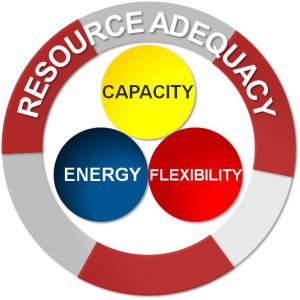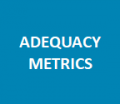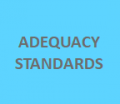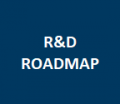Difference between revisions of "Adequacy"
EPRI ADMIN (talk | contribs) |
EPRI ADMIN (talk | contribs) |
||
| Line 5: | Line 5: | ||
Resource adequacy (RA) is an assessment of whether the current or projected resource mix is sufficient to meet capacity and energy needs for a particular grid. The resource mix refers to the mix of supply-side generation, such as solar or nuclear paired with energy storage, and demand-side flexibility, such as demand response and energy efficiency. RA assessments are used to identify potential shortfalls in the availability of resources across different time frames, from long-term planning (5 to 20+ years) to seasonal and day-ahead assessments. As the RA look-ahead time approaches real-time operations, options to address identified shortfalls become fewer and more expensive. | Resource adequacy (RA) is an assessment of whether the current or projected resource mix is sufficient to meet capacity and energy needs for a particular grid. The resource mix refers to the mix of supply-side generation, such as solar or nuclear paired with energy storage, and demand-side flexibility, such as demand response and energy efficiency. RA assessments are used to identify potential shortfalls in the availability of resources across different time frames, from long-term planning (5 to 20+ years) to seasonal and day-ahead assessments. As the RA look-ahead time approaches real-time operations, options to address identified shortfalls become fewer and more expensive. | ||
| − | Reliability is considered to have two main components, one of which is adequacy. Security, also referred to as deliverability, is the other component of reliability that ensures the network facilitates power flow and maintains stability after disturbances | + | Reliability is considered to have two main components, one of which is adequacy. Security, also referred to as deliverability, is the other component of reliability that ensures the network facilitates power flow and maintains stability after disturbances. |
| − | |||
| − | |||
=== How is adequacy measured? === | === How is adequacy measured? === | ||
Revision as of 13:10, 28 October 2020
Contents
What is Resource Adequacy?
Resource adequacy (RA) is an assessment of whether the current or projected resource mix is sufficient to meet capacity and energy needs for a particular grid. The resource mix refers to the mix of supply-side generation, such as solar or nuclear paired with energy storage, and demand-side flexibility, such as demand response and energy efficiency. RA assessments are used to identify potential shortfalls in the availability of resources across different time frames, from long-term planning (5 to 20+ years) to seasonal and day-ahead assessments. As the RA look-ahead time approaches real-time operations, options to address identified shortfalls become fewer and more expensive.
Reliability is considered to have two main components, one of which is adequacy. Security, also referred to as deliverability, is the other component of reliability that ensures the network facilitates power flow and maintains stability after disturbances.
How is adequacy measured?
Estimating RA is a critical step in ensuring a reliable power system. As part of a recent RA research effort, EPRI counted over 33 different RA metrics, with varying scopes and complexities in the way they are calculated and the insights they provide. At the simplest level, a planning reserve margin, (the amount by which available supply exceeds projected annual peak load less demand side resources), can be used to screen for adequacy. A nominal target value is about 15%, but adequacy of a system at any reserve level is dependent on the size and composition of its resources, its ties with neighboring systems, and the characteristics of its load. A range of more-complex, probabilistic metrics and methods customize this value and provide critical insights into the likelihood having sufficient resources to meet demand under projected conditions. RA metrics have been used since the 1940’s, with much debate as to what should be considered “adequate.” By 1957, a criterion of limiting loss of load expectation to less than “one day in ten years” became popular. Other common measures for resource adequacy include loss of load hours (LOLH), loss of load expectation (LOLE) and expected unserved energy (EUE) (see further reading). As an example, LOLH is often limited to 2.4 hours per year, a probabilistic interpretation of “one day in ten years.” Note that the interpretation and calculation for “one day in ten years” is often a source of confusion, with different interpretations whether calculated as one event, one hour, one day, etc. These metrics are calculated by considering a range of factors that determine the likelihood of resources not being available to meet demand and of the projected demand levels. Various methods have been developed to determine these metrics for any given power system, ranging from relatively simple models to detailed simulations.
What does it mean to have adequate resources?
RA criteria are probabilistic. That means that a system that meets RA criteria is expected to have sufficient supply and demand-side resources to meet peak system demand, with a certain level of confidence. From modeling the range of expected conditions, a system that is planned for adequacy may still experience temporary and rare periods of scarcity, some of which may lead to involuntary load shedding if the same conditions arise in real time operations. Load shedding is the interruption of customer load sufficient to balance supply and demand and to ensure available resources sufficient to respond to unforeseen disturbances or contingencies. Adequacy criteria themselves recognizes that some periods of scarcity may occur, with very low probability. Typically, these scarcity events are probable only during a confluence of conditions that would have low probability in combination. These combinations of conditions are considered so rare that planning to meet demand during these ‘very rare’ events is not cost-justifiable. In fact, some systems derive their adequacy criterion economically, searching for the limit of cost-justification. Whether searching for an optimal level of adequacy or projecting resource needs to meet an adequacy target, is Still, in a valid RA assessment it is critical that a realistic range of conditions is considered, some being beyond past experience. It should be noted that loss of load resulting from external factors such as storm damage, wildfires, or other natural disasters that interrupt delivery of power are not considered in resource adequacy.
What assumptions are made about generating capacity availability in resource adequacy?
Generators of all types may fail, even during periods of high demand. Adequacy studies account for this when considering how resources contribute to meeting demand. Traditionally, load projections and generator forced outages or partial deratings were the primary drivers in adequacy studies. Typical values for availability (the opposite of outages and derating) range from 85% to 95%, depending on the type of power plant, operational history, age, and climate conditions. RA assessments assume generators are available unless forced out or on planned maintenance. Load may also be varied across a range of expected weather and economic conditions.
Who is responsible for resource adequacy?
Setting adequacy requirements, assessing adequacy, procuring capacity, and contracting are distinct tasks that are intertwined and related to ensuring sufficient capacity. Adequacy standards and requirements normally originate in laws, regulations, or license agreements. State public utility commissions and other regulators may hold RA proceedings and approve requirements, standards, and the actions necessary to secure adequacy. RA assessments are conducted by a variety of entities. In regions with centralized wholesale markets, they may be conducted by independent system operators (ISOs), transmission system operators (TSOs), regional security coordinators (in Europe), or regulators, irrespective of who may be responsible for ensuring adequacy. In other regions, utilities are typically responsible for assessing and ensuring adequate supply themselves, using methods and criteria subject to approval by regulatory and other authorities. In the structured-market areas, there are three primary classifications of methods by which capacity is secured: 1) centralized capacity markets (e.g. PJM), 2) decentralized or regional capacity procurement (e.g. California) and 3) no explicit capacity markets (“Energy Only” markets such as in Texas).
How is resource adequacy changing?
Until recently, RA in most systems referred to having sufficient planned capacity (traditionally, dispatchable generation) to meet the expected peak demand over a study period, which may range from months to years or decades. Several factors are impacting the ability of planners to assess resource adequacy. Changing Generation Mix. There are more types of power generation, from traditional thermal generation, like coal, nuclear and natural gas-fired generation, to weather-dependent renewable generation such as hydropower, wind, and solar. These resources vary widely in their ability to produce electricity when demand is high. Demand-side resources, such as controllable or deferrable demand can contribute to RA, and battery storage is a growing resource, though its RA contribution is more complex to evaluate than for other resources. Changing Demand Characteristics. Improving energy efficiency affects future projections of energy demand. Load shapes are also changing, which may create new types of stressful periods. For example, large net-load ramps may stress systems if generators cannot respond quickly, even if there is sufficient capacity. Electrification of various parts of the economy may change load shapes and magnitudes, while also providing additional demand-side flexibility. Climate change may also impact demand and needs to be considered in studies with longer horizons. Energy-Limited Resources. The evolution of RA assessment is also shifting toward both available capacity and energy supply. Some modern resources, like batteries and demand response, have limits to their energy capability, so these factors also need to be accounted for. Hydro-dominated systems have long seen this dual need for capacity and energy. To produce a more accurate picture, RA models are becoming more sophisticated by including all the above elements, as well as transmission capacity, fuel availability, and other factors. The very nature of what constitutes an adequate system is increasingly an open question in the era of flexible demand. These changes are discussed in the later section on challenges.
Resource Center Layout
This resource center focuses on basic RA concepts, methods and metrics and more application focused topics such as study tool choices and methods to assess the impact of certain technology classes. Each of the links below brings you to a dedicated section to each issue facing practitioners when conducting adequacy studies.







